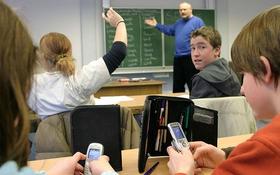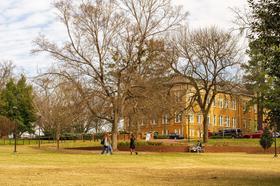Serving 138 students in grades 7-12, Waverly Jr/sr High School ranks in the bottom 50% of all schools in Illinois for overall test scores (math proficiency is bottom 50%, and reading proficiency is bottom 50%).
The percentage of students achieving proficiency in math is 15-19% (which is lower than the Illinois state average of 27%). The percentage of students achieving proficiency in reading/language arts is 20-29% (which is lower than the Illinois state average of 30%).
The student-teacher ratio of 15:1 is higher than the Illinois state level of 13:1.
Minority enrollment is 9% of the student body (majority Black and Asian), which is lower than the Illinois state average of 55% (majority Hispanic).
Quick Facts (2026)
- Grades: 7-12
- Enrollment: 138 students
- Student-Teacher Ratio: 15:1
- Minority Enrollment: 9%
- Graduation Rate: ≥80% (Btm 50% in IL)
- Overall Testing Rank: Bottom 50%
- Math Proficiency: 15-19% (Btm 50%)
- Reading Proficiency: 20-29% (Btm 50%)
- Science Proficiency: 70-79% (Top 10%)
- Source: National Center for Education Statistics (NCES), IL Dept. of Education
Top Rankings
Waverly Jr/sr High School ranks among the top 20% of public schools in Illinois for:
Category
Attribute
Most improved public schools
Science Proficiency
Community Size
School Overview
Waverly Jr/sr High School's student population of 138 students has declined by 9% over five school years.
The teacher population of 9 teachers has declined by 40% over five school years.
Grades Offered
Grades 7-12
Total Students
138 students
Gender %
Total Classroom Teachers
9 teachers
School Calendar
Last Day of School
Tue. May 26, 2026
School Motto
Building individuals for today and tomorrow.
School Rankings
Waverly Jr/sr High School ranks within the bottom 50% of all 3,542 schools in Illinois (based off of combined math and reading proficiency testing data).
The diversity score of Waverly Jr/sr High School is 0.17, which is less than the diversity score at state average of 0.69. The school's diversity has stayed relatively flat over five school years.
Overall Testing Rank
#1983 out of 3542 schools
(Bottom 50%)
(Bottom 50%)
Math Test Scores (% Proficient)
15-19%
27%
Reading/Language Arts Test Scores (% Proficient)
20-29%
30%
Science Test Scores (% Proficient)
70-79%
50%
Student-Teacher Ratio
15:1
13:1
American Indian
n/a
n/a
Asian
2%
6%
Hispanic
1%
28%
Black
2%
17%
White
91%
45%
Hawaiian
n/a
n/a
Two or more races
4%
4%
All Ethnic Groups
Graduation Rate
≥80%
87%
Eligible for Free Lunch
28%
43%
Eligible for Reduced Lunch
10%
4%
School Statewide Testing
School District Name
Source: National Center for Education Statistics (NCES), IL Dept. of Education
Profile last updated: 02/09/2025
Frequently Asked Questions
What is Waverly Jr/sr High School's ranking?
Waverly Jr/sr High School is ranked #1983 out of 3,542 schools, which ranks it among the bottom 50% of public schools in Illinois.
What schools are Waverly Jr/sr High School often compared to?
Waverly Jr/sr High Schoolis often viewed alongside schools like Franklin Jr/sr High School by visitors of our site.
What percent of students have achieved state testing proficiency in math and reading?
15-19% of students have achieved math proficiency (compared to the 27% IL state average), while 20-29% of students have achieved reading proficiency (compared to the 30% IL state average).
What is the graduation rate of Waverly Jr/sr High School?
The graduation rate of Waverly Jr/sr High School is 80%, which is lower than the Illinois state average of 87%.
How many students attend Waverly Jr/sr High School?
138 students attend Waverly Jr/sr High School.
What is the racial composition of the student body?
91% of Waverly Jr/sr High School students are White, 4% of students are Two or more races, 2% of students are Asian, 2% of students are Black, and 1% of students are Hispanic.
What is the student-teacher ratio of Waverly Jr/sr High School?
Waverly Jr/sr High School has a student ration of 15:1, which is higher than the Illinois state average of 13:1.
What grades does Waverly Jr/sr High School offer ?
Waverly Jr/sr High School offers enrollment in grades 7-12
What school district is Waverly Jr/sr High School part of?
Waverly Jr/sr High School is part of Waverly Community Unit School District 6.
School Reviews
Review Waverly Jr/sr High School. Reviews should be a few sentences in length. Please include any comments on:
- Quality of academic programs, teachers, and facilities
- Availability of music, art, sports and other extracurricular activities
Recent Articles

Public School Transportation & Commute Planning Guide
Learn how public school transportation and commute planning can help families prepare for the coming school year safely and efficiently.

New Public School Safety Protocols 2025–26 Guide
Learn how new public school safety protocols for 2025–26 affect students, parents, and schools nationwide.

How Technology Transforms Education in 2025
Explore how technology shapes learning today, with updated data, policy context, trends, and real-world implications for students, educators, and families.





